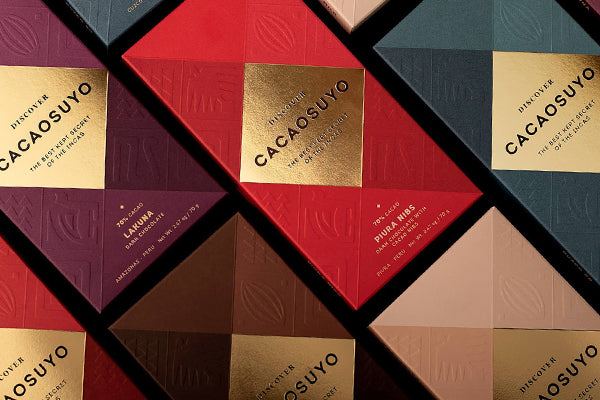If you haven’t tried Peruvian chocolate, you can’t call yourself a true chocolate lover.
That’s not to say you haven’t sampled new-wave, artisan chocolate. It’s been on the rise for the past few years. The US craft chocolate market is estimated at $100 million and growing. The Fine Chocolate Industry Association reports a rapid growth in the number of US craft chocolate makers. The latest count puts the total over 300.
While domestic producers of artisan chocolate offer superlative examples of the bean-to-bar movement, there’s no comparison to the chocolate coming out of Peru.
Peruvian chocolate cleaned up at the International Chocolate Awards in 2020, collecting a total of 17 awards across all major categories—the most of any country. Cacaosuyo, a Peruvian cacao chocolatier that features single origin domestic varieties, took top honors in the plain/dark origin category as well as three special category awards.
Looking to purchase this award winning chocolate? We offer the top flavors from Cacaosuyo.
Buy Peruvian Chocolate: Cacaosuyo Peruvian Dark Chocolate (2.47oz).
Want to learn more? Keep reading to discover the secret behind this world-class chocolate.

A Quick History on Peru & Chocolate
Despite the international community recently waking up to the excellence of Peruvian chocolate, this South American powerhouse has a long history in cacao production.
Cacao and chocolate have been around for thousands of years.
Experts generally agree (despite considerable debate) that the Theobroma tree originated in the Amazon rainforest. Indigenous communities of the Amazon have been cultivating cacao for more than 3,000 years. The Incas consumed cacao in a fermented beverage for medicinal and ritualistic purposes.
Bitter, nutritious, and potent, this was the fuel of the mighty Incan empire.

Peru, the World’s Fine Cacao Powerhouse
Peru is the world’s largest organic cacao producer and 9th largest total cacao producer. Organic Peruvian cacao is considered some of the best in the world.
60 to 70% of Peru cacao bean production is exported in either bean form or cacao derivatives. Beloved by artisan chocolate makers across the world, Peru cacao beans are the chocolate insider’s favorite.
More than 50,000 Peruvians earn a living through the cacao trade. Cacao production is split among thousands of small farmers. The Peruvian cacao farmer tends an average plot of around two hectares. Total cacao production spans an area of 40,000 cacao hectares across the Eastern Andes and Peruvian Amazon rainforest. The cacao yield per hectare ranges from 1 to 2.5 metric tons.

Ancestral Home of the Cacao Tree
The Amazon rainforest provides the perfect home for the cacao tree. It grows in a limited geographical zone, 20 degrees north and south of the equator.
The Theobroma cacao tree is finicky. It prefers fertile, slightly acidic soil that drains well. Temperatures can’t be too hot or too cold—ideally, 77°F to 80°F—and stable rainfall between 50 and 100 inches is desired. The cacao tree is sensitive to strong wind and direct sunlight, and thrives under the canopy of taller growing trees in the rainforest.
The Peruvian amazon covers 302,000 square miles and holds a wide diversity of cacao. Peruvian cacao grows in the jungle areas of Cajamarca, Huánuco, Junín, Ayacucho and Cusco, as well as the Amazon regions of Amazonas, San Martín and Ucayali. It also grows along the northern coast in Tumbes and Piura.
Peru checks all the boxes when it comes to the ideal cacao growing conditions.
What makes Peruvian chocolate so special?
The International Cocoa Organization assigns the world’s best cacao with the designation fine or flavor. This label distinguishes quality cacao with unique aromas and flavors. A whopping 75% of Peru’s cacao production is fine or flavor. For context, only 10% of the world’s production attains this designation. Indonesia, a major producer of cacao, only produces 1% fine or flavor.
The secret is in the cacao.
 Peru is home to a dramatically diverse range of cultivar strains of cacao. It boasts 6 of the 10 genetic families of cacao that exist in the world. Peruvian cacao cultivation focuses on three main varieties—Criollo, Forastero, and Trinitario. Each of these cacao varieties offer different aromatic and flavor profiles that contribute to the world’s best chocolate.
Peru is home to a dramatically diverse range of cultivar strains of cacao. It boasts 6 of the 10 genetic families of cacao that exist in the world. Peruvian cacao cultivation focuses on three main varieties—Criollo, Forastero, and Trinitario. Each of these cacao varieties offer different aromatic and flavor profiles that contribute to the world’s best chocolate.
Criollo
The most popular and desired cacao in Peru, hence the nickname King of Cacao. Criollo beans contain high fat content with finer qualities of taste and aroma. Offers notes of caramel, nuts, vanilla, and tobacco. Contains less classic chocolate flavors. Accounts for around 5% of cacao production worldwide.
Forastero
The most common cacao worldwide. The Forastero accounts for 80% of global chocolate production. More assertive than Criollo, this cacao offers more acidity with bitter, chocolatey notes. Forastero chocolate tends to be fruiter—with notes of red berry and cherry—when compared to Criollo. It’s a character that makes it a favorite in the chocolate world.
Trinitario
A hybrid variety of Criollo and Forastero. This cacao originated in Trinidad (hence the name) and accounts for 12% of world production. Influenced by its growing conditions, the Trinitario offers a variable flavor profile that anchors around strong raw cacao flavor. Less bitter than the Forastero.

The White Criollo Cacao
There’s one other cacao worth mentioning—the fabled Peruvian white cacao bean. When it comes to rare cacao beans, this is the holy grail.
The White Criollo has enchanted chocolate lovers around the world. It inspired the infamous jungle hike by chef Eric Ripert and the late Anthony Bourdain. The bean is a genetic mutation. A product of hundreds of years, untouched by the human hand. It has a subtle flavor profile, significantly less bitter and acidic than other cacao. It’s revered for delicate, ethereal flavor notes.
Try Peruvian white cacao beans in Piura Select 70% Cacao from Cacaosuyo.
All cacao types benefit from the biologically diverse growing regions in Peru. This is where the magic happens. The growing conditions are what makes Peruvian chocolate special.

The concept of terroir (often used in wine) applies perfectly here. The harmony of plant genetics, soil, and ideal climate result in some of the world's best cacao production. The cacao beans are revered around the world. But beans are half the story.
Similar to the relationship of a winemaker to grapes, the chocolate manufacturer unlocks the flavors hidden in the beans. You can’t make good wine without good grapes, and you can’t make good chocolate without good beans.
Enter Cacaosuyo.

Meet Peru’s Best Chocolate
Founders Sam Giha and Eduardo Lanfranco created Cacaosuyo with one goal—create the best chocolate in Peru. Cacaosuyo not only produces organic Peruvian chocolate from tree to bar, they partner with local producers in each step. They can trace the genetics, origin, and quality of the cacao used in each bar of chocolate. Cacaosuyo’s approach is not only innovative in South American chocolate, but in the international community as well.
Cacaosuyo is on the leading front of a movement to transition more Peruvian cacao production from export to domestic use. With growing international acclaim, it’s safe to say this is a movement worth supporting. Cacaosuyo might have to reconsider its tagline—the best kept secret of the Incas—because it’s a secret that won’t last long.
Buy Cacaosuyo: Cacaosuyo Peruvian Dark Chocolate (2.47oz)


